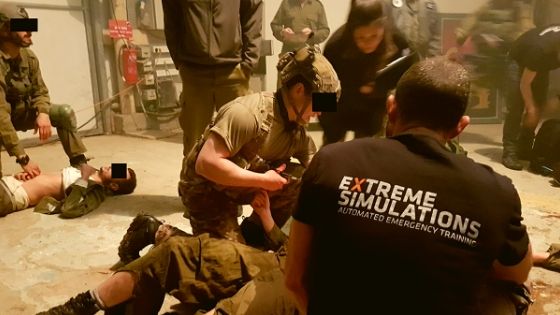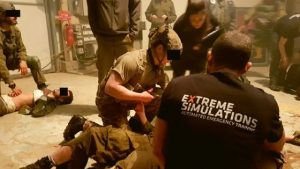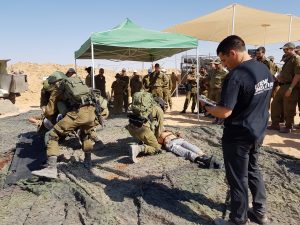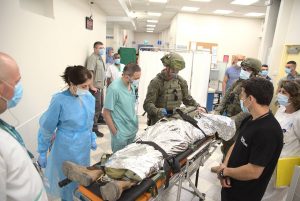Fact: one of the most difficult effects to achieve during the simulation of a real-life event is the mental challenge.
Why? The mental challenge is the result of several factors, combined:
- The way in which we experience the incident – this is the largest “surprise” factor and it might include feelings of guilt towards possible mistakes you may have made, or concerns about your ability to function
- Managing to go over the disturbing and hard sights
- Fear caused by the unknown (what has happened, what will happen next, what happened to my team, how do I save myself/ourselves etc..)
So keep in mind that the actual event could be more stressful, more demanding, and might feel like a “first time experience” even though you went through several pieces of training before.

What is a real-life extreme event?
A real-life extreme event is characterized by the following:
- It is mentally challenging: it feels like a first-time experience, something you’ve never done before. You might feel like you don’t know what you need to do, which in turn can raise your stress levels.
- Speaking about stress, the event creates a lot of confusion, which leads to high levels of stress.
- An extreme event usually includes wounded and/or kidnapped casualties
- You will have no access or limited access to resources, so your ability to improvise on the spot is of core importance.
- Disorder is the defining word for an extreme incident. Nothing is how it is supposed to be and you need to make chaos work with you (and for you), but very often it will be difficult to understand the situation at hand. As a result, your response to it is harder.
Learn more about the characteristics of an extreme incident here

Instruments that contribute to a successful simulation of a real-life event
The success of a simulation of a real-life event relies on the careful orchestration of all the elements that make up an extreme event.

What is expected from a hyper realistic simulation?
- Expect the unexpected: at an operational level, expect problems to appear in places where we did not ask the right questions, instead of them appearing in the “obvious” places. This contributes to creating the element of surprise.
- An extreme event will require high levels of logistical, medical and operational coordination at all levels of command.
- Requires skills that deviate from basic techniques and involve improvisation, leadership and decision-making skills.

There are multiple layers that make up a simulation event. You start with technical training, the first layer, to which other layers are added to maximize the experience.
For example, stopping a bleed by applying a tourniquet on a task trainer is important to learn the basic procedure and to strengthen a person’s confidence. But it does not teach you how to treat a wounded person who screams and moves while bleeding.
You need to ensure that technical skills are combined with other skills in order to achieve the desired result.

How do you achieve that “mental pressure” effect during a simulation of a real-life event?
As mentioned at the beginning of this article, the mental challenge – which is the dominant component of a real-life event – is the most difficult element to obtain during a simulation.

How do we do it?
In the case of a hyper-realistic simulation of a real-life event, you want to get as close as possible to the real deal. You want trainees to tell you, when everything is over, “Wow, it felt like everything was real!”
To achieve this, our specialists will:
- Create mental manipulations which lead to a stressful situation
- Come up with logistical & management challenges
- Include real parameters for measuring medical treatment
- Provide empiric learning (this provides more than just an experience, but also parameters that can be measured and monitored)
- Always include an element of surprise that will contribute to the rise of stress levels

In addition to the stress factors mentioned above, other elements are included in the simulation of a real-life event, such as:
- Creating a multi-sensory experience (that involves sight, smell, sound, and touch), which prepares the trainee for the mental challenges of being in a real incident.
- Making you deal with real and unexpected challenges which require resourcefulness and resilience.
- Teaching you to overcome challenges and focus on the immediate situation.
- Highlighting cross-organizational challenges that may occur from the point of injury to hospitalization.
- Teaching the trainees to work with unfamiliar equipment and in harsh environments.
- Enabling the organization to identify gaps based on the orange capability triangle: Mental + Medical + Operational capabilities.
An extreme event often goes hand in hand with the management of missing persons & casualty identification.

Who should you train with?
As you can see, stress is a leading factor that defines your reaction to an extreme event. Therefore, it is crucial that you go through regular simulations of a real-life event, so much so that your reactions become second nature.
This way, even if you are under big levels of stress, your mind will automatically enter “rescue” mode and implement all the strategies you learned during the simulation.

Our experienced specialists at Extreme Simulations will outline a tailor-made training course for all levels of the organization: from field operators and mid-level managers to executive levels.
We often hear from our clients that their training felt like a real-life event, which is exactly what we want to hear from them not because we like what we hear, but because we know that they are prepared for survival.
GET IN TOUCH
Contact Extreme Simulations now to book a complete training session





